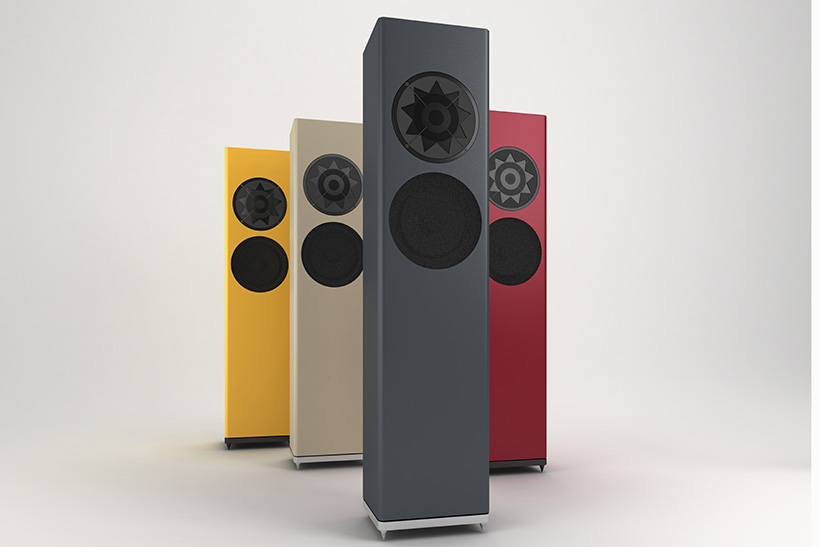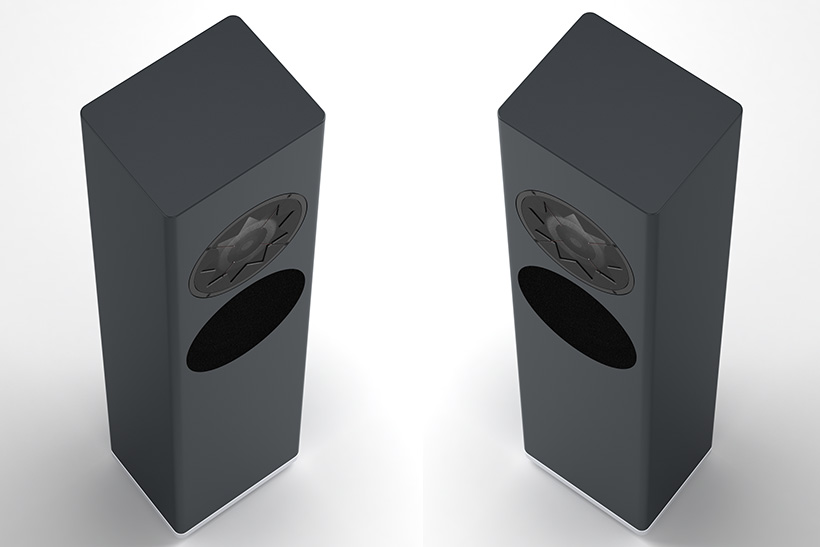By way of an upside-down review, and to save you scrolling to the conclusion at this point, I wanted to like this product. I had liked this product at a couple of recent European events (no, correction: I absolutely adored the sound they made), and, thankfully, after correct amp-matching and room placement– I did like this product… to the extent that I shall probably shed a few tears when they have to be shipped back to Germany any day now.
Initial sounds
So eager was I to listen to the Manger p1 floorstanders that I rushed round to ear-drupal.papazetis.com’s offices as soon as the shipment arrived. Pressing the Editor to hook then up to the reference system (comprising a not-inexpensive Naim amplifier) we sat back. Within a few bars of St Matthew’s Passion (Peter Schreier et al on Phillips) my heart sank. It was as though the players, the soloists and the chorus were disembodied. This is not how I’d remembered these technologically-advanced speakers from either the Bonn show or from an exhilarating event by Belgium high-end dealer Gydotron. On both occasions the music gave me goose-bumps and an involuntary movement of the feet to tap-away in time to the music. But now all was rather lacklustre by comparison.
Leaping to his feet, Editor Kennedy deftly changed the amplifier to another British affair, a (less costly than the Naim) ATC. We settled down with a pot of Darjeeling and tried again. An instant improvement, yes, but still nowhere near the performance I knew the speakers were capable of.
Setting up
Without more ado the speakers were shuttled to the Butler household. I had recalled some talk, in Belgium, of a laborious set-up for this model and, without hesitation, contacted my dear friends at distributors Audio Ingang. Yes, admitted Garmt, the p1 set-up can be rather elaborate. Too much so to detail in an email, but I am grateful for the rough ‘n’ ready version he kindly supplied and which, I am thankful to say, restored the magical 3D sound that I’d fallen in love with at the two public events.

Essentially, the sealed-box p1 speakers need to be about 2-2.5m apart and some 30cm from the wall to start with and brought in gradually until the most musical rhythm and bass are achieved. And, boy, can these beauties deliver decent, well-defined and lively bass combined with plenty of rhythm and an excellent sense of timing. The second trick is to toe them in so that their axis cross well in front of the listener, in fact about half a metre in front. By using classical music it’s obvious when you hit the right spot as there’s a stable, 3D image wherever you are in the room. In fact, a further tweak to bring the speakers just a smidgen closer together improved things even more.
Listening in earnest
Everything set up I found that my usual amplifier, also German (Trigon Dwarf II monoblocks) provided an admirable coupling where the Naim and ATC had been less successful. Don’t let anyone tell you that ‘all amplifiers sound the same’ or that ‘it doesn’t matter what you hook-up to our speakers, it’ll be fine’. Bunkum!
What better place to start than with the Manger-supplied sampler CD of 15 tracks, some which are a real delight. Take, for example, the excellent jazz recordings included (trio, quartet and percussion ensemble) which soon had my toes tapping and knees jiggling in an involuntary way which I’m just not used to with my BBC-style monitors (a speaker genre I’ve been addicted to for several generations now, dating back to the old BC1 and the hugely-talented Richard Ross designs when he was at Rogers, such as the magical LS7t – I ‘grew-up’ with the original LS5/8 and LS5/9 while cutting my teeth in BBC studios). Musicality is the p1’s watchword, it has an ability to extract subtle nuances from tracks and transport the listener to the recording venue; those jazz clubs seems so realistic on playback, so vivid and detailed, so rich in detail.
With the Chesky recording of Livingston Taylor’s ‘Isn’t She Lovely’ there’s an immediate urge to tap along to the beat and to listen to more of the same, such is the level of micro-resolution. So much so that on the first night of auditioning it was two in the morning before I realised it. Not in a long while have I had the urge to listen continually for so long: album after album came out for an airing.

The p1 is a sealed cabinet loudspeaker, with all the bass advantages this can bring. In fact, the enclosure is in three-parts, one for the woofer, one for the magical Manger driver and one at the bottom (which in the s1 active version can house the power amplifier). That lovely warm, energising bass made Marla Glenn (‘The Cost Of Freedom’) even more of a delight to listen to than usual, while the saxophone on Yuri Honing’s ‘Walking On The Moon’ came alive and was transported to my room. Then the drums kick in. Wow! Dynamics or what? This really is akin to the emulation of a full-range, high-end system costing many times the amount, making the p1 something of an audiophile bargain.
Orchestral tracks on the complimentary CD include extracts from Beethoven’s Sonata No. 8 (Denon) and Hayden’s Symphony 67 (Blomstedt) and the BPO’s ‘Pulcinella’ suite. Again, wonderfully involving performances, with a deep and wide soundstage. The grandeur of the works challenged the p1’s ability to reproduce the entire scale and torrent of sound from so many musicians, but it has colourful dynamics and an ability to reveal detail and subtleties. It was turning to speech, well-known BBC dramas and monologues which really unsettled the Manger design and revealed what appeared to be a mild suck-out in the presence region, rendering famous voices such as Gielgud and Ian Carmichael slightly unnatural yet entertaining nonetheless. Heavily compressed punk and reggae also challenged the design, but then people who love a bit of kick-ass music are not the customers Manger expect to invest in high performance, high quality loudspeakers such as the p1. The refined p1 is about letting the music deliver its emotional message and that they do in abundance, bringing the musicians closer to the listener with a realism that betters many a loudspeaker costing considerably more. Acoustic instruments are placed there, in the room, sounding just so natural, so right. The goose pimples are back along with a warm, tingly sensation of satisfaction.

It’s with smaller-scale works that the p1 revels and the magic of Leonard Cohen (Live in London) put me back in the recording venue with a realism that urged me to reach out and engage the man. The smooth treble response is so well integrated as to create a holographic re-creation of the performance, there’s a sparkle to the treble that brings music alive with brilliance and energy. It all seems so effortless for the Manger driver and such a delight to listen to.
The technology
So, what makes the Manger floorstanders special. Well, that’s down to the man who founded the company 45 years ago and designed the legendary time-correct, bending-wave transducer that bares his name. Josef W Manger lodged several Patents in the 1960s and ‘70s to protect his design as he created his first prototypes. Since then the driver has been in continual development by Manger assisted by his daughter Daniela (also a chartered engineer) who today manages the company.
Manger’s ingenious drive unit replicates the basilar membrane in the human ear and produces acoustic signals that are temporally and tonally correct at the same time. Avoiding the piston-shaped movement of a conventional driver, Manger created a bending-wave transducer with a flat, circular membrane of angular flexible foil, excited by a voice coil to make back and forth movements. Yet, and here’s the clever part, its waves radiate concentrically from the centre to the edge; the voice coil only having to excite the membrane’s centre for the sounds to be radiated by the bending waves around the coil.
This full-range drive unit is supplemented by a dedicated woofer in the p1 simply because the transducer can move only a certain amount of air below about 80Hz, and people expect a design of this size and price to play loudly. In fact, the p1 performs extremely well in the near field and at low to moderate listening levels.
The p1 is the brand’s passive flagship model: tall, elegant even slightly imposing, it is available in a variety of finishes to suit different tastes or professional installation. I am told that musicians such as Hubert von Goisern and Nils Petter Molvaer rely on the Manger models. Not only is the entire loudspeaker manufactured in Germany, to the exacting engineering standards we expect, but the firm remains a family business which individually handcrafts each unit to unprecedented precision – with tolerances down to a staggering thousandth of a millimetre.


